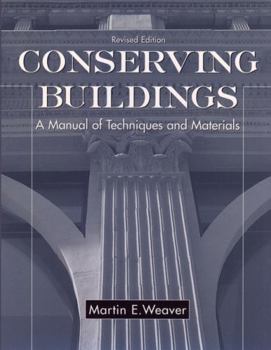Conserving Buildings: A Manual of Techniques and Materials
Select Format
Select Condition 
Book Overview
Dieser Band ist eine praktische und aktuelle Informationsquelle für Auftragnehmer - Architekten, Architekturstudenten, Ingenieure - und Hausbesitzer, die mit der Erhaltung und Restaurierung historischer Gebäude zu tun haben. Eigenschaften, Zusammensetzung und Ursachen des Verfalls verschiedener Baumaterialien werden ausführlich erklärt. 188 Photos und Zeichnungen erleichtern das Verständnis.
Format:Paperback
Language:English
ISBN:0471509442
ISBN13:9780471509448
Release Date:January 1997
Publisher:Wiley
Length:288 Pages
Weight:1.58 lbs.
Dimensions:0.6" x 8.5" x 10.9"
Customer Reviews
4 ratings
a necessary guide
Published by Thriftbooks.com User , 15 years ago
Martin Weaver was a professor of mine and his reputation in the field of historic preservation/conservation is/was (he died a few years ago) well known among those of us in the profession. The book is an excellent resource, very detailed and yet easy to read, and you can be assured of its accuracy as it's written by a true, hands-on conservator using his own experiences to illustrate the methods he talks about.
Conserving Buildings
Published by Thriftbooks.com User , 15 years ago
This book tells you how best to conserve either historic buildings or modern buildings. It shows how insects may be a problem, how pollution can affect buildings, and then goes on to explain how best to approach various restoration issues. The book covers plaster and concrete, architectural metals, and brickwork, to name a few. In a way it is like what you might hear on This Old House or some other renovation television program. There may be a limited target audience for a book like this, but having it on the bookshelf of the Facilities Manager may be a wise investment.
Complete technical reference
Published by Thriftbooks.com User , 22 years ago
I bought this to learn more about building materials--wood, stone, concrete, metals--and was not disappointed. Each chapter begins with a summary that's authoritative but friendly. And interesting. You'll learn, for example, that the trick to making a hydraulic cement is to add some siliceous mineral to the limestone before firing in a kiln. The Romans used volcanic rock; modern Portland cement producers find it in certain clays. You'll realize none of these materials can stand up to water, which eventually returns them to their more chemically stable states, changing concrete into limestone, smelted metals back to ores (rust), and turning wood into food for other living things.What follows the introductory discussion is probably too technical for non-professionals--references to ASTM standards, specifications for water jet delivery in gallons per minute and PSI when cleaning stone, and tips for making your own epoxy using bulk chemicals, complete with Dow Chemical part numbers.I was a little disappointed by the presentation--B/W photos by the author and very basic drawings--but I suppose that's all that's needed for a book like this.
If only I had opened this book before the exam.
Published by Thriftbooks.com User , 24 years ago
A wonderful reference tool for the professional conservitor, or even the "Matha Stewart" home fixer-uper.






